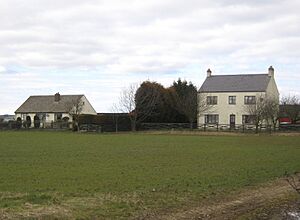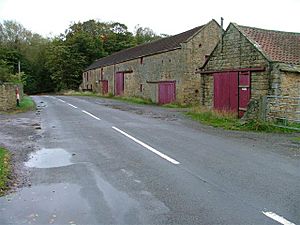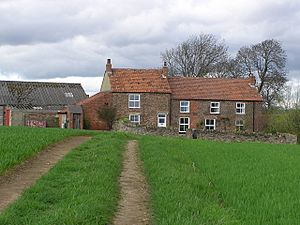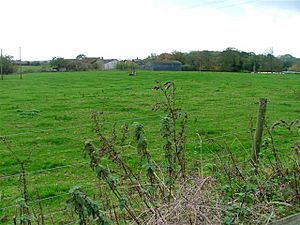Walworth, County Durham facts for kids
Quick facts for kids Walworth |
|
|---|---|
 Cuckoo House, an outlying part of Walworth |
|
| Population | 240 (including Archdeacon Newton and Houghton-le-Side. 2011) |
| OS grid reference | NZ234188 |
| Unitary authority |
|
| Ceremonial county | |
| Region | |
| Country | England |
| Sovereign state | United Kingdom |
| Post town | Darlington |
| Postcode district | DL2 |
| Dialling code | 01325 |
| Police | Durham |
| Fire | County Durham and Darlington |
| Ambulance | North East |
| EU Parliament | North East England |
| UK Parliament |
|
Walworth is a small village in County Durham, England. It is located near Darlington. The village is made up of a main area and some farms spread out around it.
Walworth is known for its 16th-century Walworth Castle. This old castle is now a hotel. There are also signs of a "lost village" nearby. This means there was once an older settlement here that no longer exists.
Contents
Where is Walworth Located?
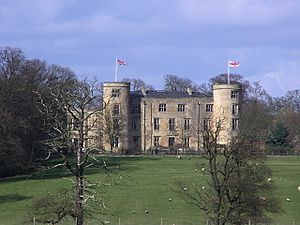
Walworth is about 2.5 miles (4 km) northwest of Darlington. It sits where Newton Lane meets Walworth Road. Some people believe Walworth and Walworth Gate are on the path of an old Roman road called Dere Street.
The village has a triangular shape. Walworth Castle is right in the middle. North Farm and the lost village area are at one corner. Castle Farm is at another, and Walworth Grange is at the third corner. Walworth used to be part of a different parish, but now it has its own. Even though there was an old chapel, the village does not have a church today.
How Many People Live in Walworth?
The population of Walworth is quite small. In 2011, about 240 people lived in the civil parish of Walworth.
Walworth Castle: A Historic Hotel
The most important building in Walworth is its large, 16th-century mansion. It looks like a medieval castle. This building is now a hotel. It is a Grade 1 listed building, which means it is a very important historical site. It was likely built around 1600 for Thomas Jennison. There are signs in Walworth Park, near the castle, that suggest another lost settlement might have been there.
A Look at Walworth's History
The name "Walworth" means "Welsh settlement." It was once called Waleberge after the Anglo-Saxons took it over. The Hansard family probably planned Walworth as a village around 1150. They owned a large estate here.
There's a story that Malcolm III of Scotland destroyed the village long ago. After the Black Death in the 1300s, the Neville family took over the land. But then Robert Hansard claimed it back. Later, the Ayscough family and then Thomas Jenison owned the manor. In 1605, the farm had many animals, including 50 oxen!
The Jenison family lost the estate in 1759 due to debts. Then, the Stephenson and Aylmer families owned it. In 1950, Durham County Council bought it. The estate was later sold off in pieces in 1981.
Discovering Walworth's Old Sites
There isn't much proof of very old activity from prehistoric or Roman times here. However, the area has not been fully explored by archaeologists. In 2004, a special arrowhead was found near Quarry Cottage. It might have been moved from its original spot because it was found in an old quarry.
Walworth has several interesting old sites:
- Brick and Tile Works: There were two places nearby that made bricks and tiles a long time ago.
- Lime Kilns: These were ovens used to heat limestone to make lime. There was one north of the village and another at Quarry Hole.
- Paradise Cottage: This old cottage, once called Hood's Cottage, has an old well nearby.
- Old Well: There's an overgrown stone well near Walworth Castle. It has a trough to collect water.
- Medieval Mill Site: About 0.31 miles (0.5 km) west of Walworth, there might have been a medieval mill. We know this from old maps and writings.
- Ice House: This building from the late 1700s or early 1800s was used to store ice. It's built into a bank and has a deep, egg-shaped room for the ice.
- Threshing Barn and Gin Gang: On the east side of Walworth Grange, there's an old barn and a "gin gang." A gin gang was a building where horses walked in a circle to power farm machinery.
At Castle Farm, there's an old farmhouse called Parkside Farmhouse. It was built in the early 1800s. It has a large, two-story dovecote, which is a building for pigeons. There are also old sheds and a haybarn nearby.
The Lost Settlement at North Farm
At the north end of Walworth, near North Farm, you can see signs of a "lost settlement." These are earthworks, which are changes in the ground that show where old buildings and ditches used to be. There are ruins and foundations of old buildings.
An old chapel, built in 1180, is now part of the North Farm buildings. You can still see where the original doors and windows were. Inside, there are signs of old church features like a piscina (a basin for washing sacred vessels) and an aumbry (a cupboard for church items). There are also signs of old "ridge and furrow" fields in Walworth Park. These were fields where crops were grown in raised rows, and they might be connected to this lost village.



